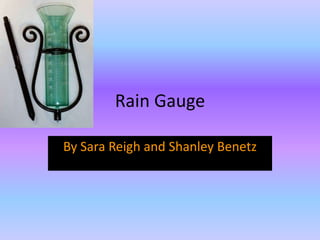
Rain Gauge- Period 5
- 1. Rain Gauge By Sara Reigh and Shanley Benetz
- 2. Who invented it? It was invented in the year 1441 by King Sejong and his son, Prince Munjong. They came from Korea and sent this measuring tool throughout their kingdom. They used the gauge to assess land taxes based on farmer’s potential harvest. King Sejong first thought to dig a hole in the ground. Prince Munjong, later when he was King, decided just to put out a container.
- 3. What is the history of rain gauges? There were some records of people measuring the amount of rainfall but it wasn’t actually invented until 1441. In 500 B.C. there is some record of Ancient Greeks measuring the amount of rainfall. 100 years later, people in India started using a bowl and used the results collected as basis for land taxes. Flag of India
- 4. What is it used for? The rain gauge is used to measure precipitation in the form of water. The gauge is not very accurate because there are many things that can affect the results. Like buildings, wind, landscaping, and trees. To get accurate results, the best place to set a rain gauge is in an open area where wind will not affect the results.
- 5. How does it work? The rain gauge has three main parts: a funnel, a measuring tube, and an overflow tube. Most of them also come with a bracket to attach it to something. The funnel is at the top and is connected to the measuring tube. The measuring tube is inside the outside overflow tube. The funnel leads the rain into the measuring tube and magnifies 10 times. A smaller measuring tube allows a more precise precipitation measurement. An inside tube measures up to an inch of water and if there is more than an inch of rain it will overflow into the outer cylinder. Measures the amount of rainfall in milliliters.
- 6. How are they used? To measure total rainfall over a period of time. It can measure per day or per storm. If monitored at a regular rate you can determine the rainfall rate in centimeters per hour. Data from multiple rainfall stations can be used to predict when a river will reach its maximum height and whether it will flood or not.
- 8. Some rain gauges may have another tube outside the first one.
- 10. Other Useful Info This instrument is thought to be the oldest weather measuring instrument. Some of them are heated so that when it is below freezing outside it doesn’t interfere with the data. Also, the heat melts the snow and they can collect the amount of snow in the form of water.
